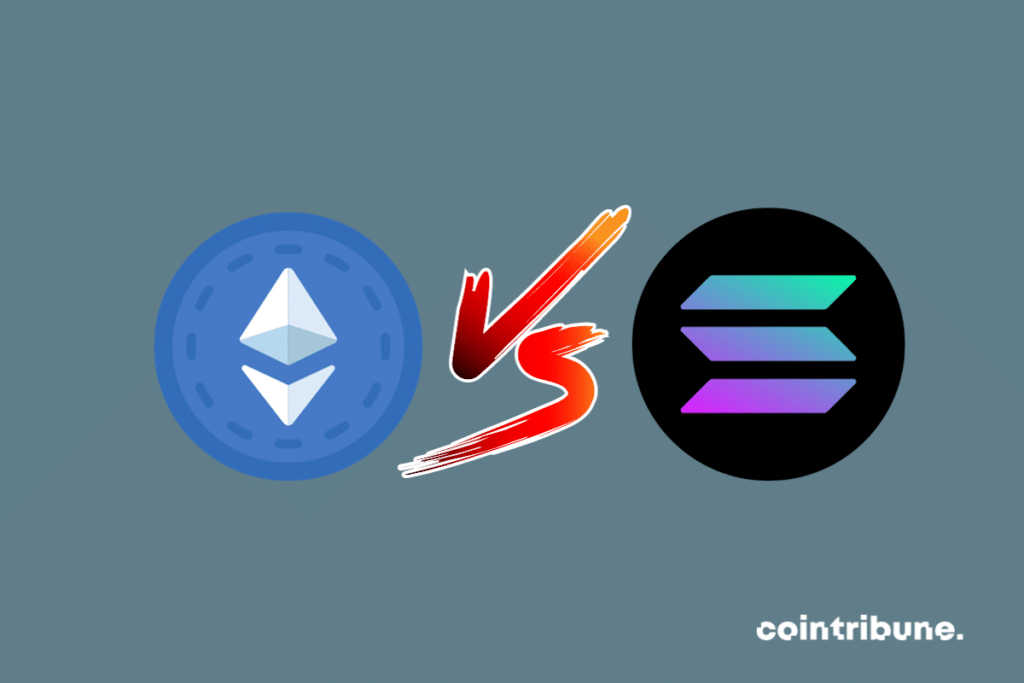Change happens fast. Solana now rivals or surpasses Ethereum across:
— Ryan Watkins (@RyanWatkins_) December 19, 2023
– DEX Volumes
– NFT Volumes
– Active Addresses
– Transaction Count
– Stablecoin Transfers
“But Solana isn’t decentralized 😤”
Reality: Solana has ~40% the amount of nodes as Ethereum, they’re only ~5x more… pic.twitter.com/ZBuLiTcXmf
A
A
Solana Excels and Outperforms Ethereum!
Thu 21 Dec 2023 ▪
4
min read ▪ by
Getting informed
▪
The Solana crypto platform is making waves. Its remarkable performance across key indicators, in comparison to Ethereum, is drawing attention. It’s surely a sign of some dynamism. However, this comes with certain operational cost limitations. We’ll explain everything.

Solana outperforms Ethereum according to major crypto indicators
Recent data indicates that the Solana blockchain protocol is quickly gaining ground and surpassing Ethereum in key metrics. This trend highlights a notable shift in the crypto ecosystem.
Data brought to light by Ryan Watkins, co-founder of Syncracy Capital, showcases Solana’s impressive performance in terms of decentralized exchange (DEX) volumes, non-fungible tokens (NFTs), active addresses, number of transactions, and stablecoin transfers.
This bullish momentum of Solana coincides with a significant rise in the price of SOL, Solana’s native cryptocurrency. It has reached new heights, breaking through immediate resistance levels in recent months of trading.
The bullish trend in the crypto market has propelled SOL prices. This has revitalized activities on this blockchain. It is evidenced by the increase in the number of transactions and the rise in its total value locked (TVL) in the decentralized finance (DeFi) segment.
The drivers of this momentum are due to Solana’s scalability. A feature that allows deployed protocols to execute transactions and launch smart contracts at a lower cost. All this is supported by a blockchain infrastructure based on independent nodes rewarded for their commitment, which promotes decentralization and security. But there is a catch.
The costly operation of nodes in Solana
Beyond this remarkable performance, the analysis also highlights a crucial aspect concerning the operational cost of running Solana nodes. It turns out that operating a Solana node is about five times more expensive than running an Ethereum node.
The data provided by Syncrancy clearly puts this cost difference into perspective. Operating an Ethereum node costs about 550 dollars, whereas running a high-end Solana node on Firedancer costs 5,100 dollars.
This is paradoxical given that Solana boasts about having approximately 40 % of the number of nodes compared to Ethereum. Even though the platform seems to be addressing this weakness with its relevance in terms of decentralization. In this regard, the Nakamoto coefficient, a decentralization indicator, shows a higher figure for Solana, at 21 compared to only 2 for Ethereum.
Moreover, Solana is committed to maximizing its lead in terms of decentralization. To this end, the crypto platform plans to launch the Firedancer validation tool, which aims to diversify and strengthen its network.
This is expected to enable it to accelerate block production. While allowing the mainnet to evolve towards processing more crypto transactions on the blockchain, without relying on external alternatives.
Maximize your Cointribune experience with our "Read to Earn" program! For every article you read, earn points and access exclusive rewards. Sign up now and start earning benefits.
A
A
Diplômé de Sciences Po Toulouse et titulaire d'une certification consultant blockchain délivrée par Alyra, j'ai rejoint l'aventure Cointribune en 2019. Convaincu du potentiel de la blockchain pour transformer de nombreux secteurs de l'économie, j'ai pris l'engagement de sensibiliser et d'informer le grand public sur cet écosystème en constante évolution. Mon objectif est de permettre à chacun de mieux comprendre la blockchain et de saisir les opportunités qu'elle offre. Je m'efforce chaque jour de fournir une analyse objective de l'actualité, de décrypter les tendances du marché, de relayer les dernières innovations technologiques et de mettre en perspective les enjeux économiques et sociétaux de cette révolution en marche.
DISCLAIMER
The views, thoughts, and opinions expressed in this article belong solely to the author, and should not be taken as investment advice. Do your own research before taking any investment decisions.